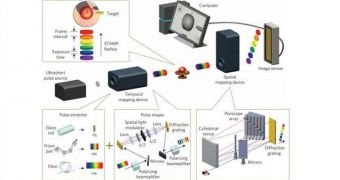Japan is home to some of the world’s major photo gear manufacturers like Sony, Nikon or Olympus. So it’s no wonder that the country has made a lot of progress in this field.
Today’s story focuses on digital optics, as a joint group of researchers working at two separate Japanese universities have developed what’s being called the “world’s fastest camera” (as seen at Phys.org).
High-speed photography is an important tool if you’re involved in studying phenomena like fast dynamics in photochemistry, spintronics (emerging technology exploiting the intrinsic spin of the electron along with its magnetic moment), phononics (a branch in physics concerned with phonons), fluidics and plasma physics.
However, high-speed photography is not only limited to the world of science. For example, the technique could allow ordinary photographers, like you and me, to check out things that wouldn't be otherwise visible.
The report gives us the example of slowing down a sports action to the level of mechanical processes.
Before this important breakthrough, high-speed photography revolved around the pump-probe method. But the technique is quite tedious, consisting of repetitive measurements for image construction. Not to mention that it fails when faced with an event which can’t be completely replicated.
The new camera will employ motion-based femtophotography, which is a complex term for saying that the device will snap images in single-shot bursts for image acquisition. Therefore, no repetitive measurements will enter the equation.
Compared to the technique detailed above, the new one is said to be 1,000 times faster. Furthermore, the world’s fastest camera should be able to shoot at a resolution of 450 x 450 pixels.
The team has dubbed the technology Sequential Timed All-optical Mapping Photography or STAMP. Researchers having contributed to the breakthrough activate at the Keio University and the University of Tokyo, respectively.
Even as this is an important breakthrough in the field, you shouldn't be getting your hopes up because we won’t see the technology arrive in digital cameras any time soon.
For the time being, the scientific field is the only niche to be enjoying the advantages of the new system. If the technology passes testing phases, then there will be hope that someday a product taking advantage of STAMP will become available for the average consumer, as well.
The team behind the project expects their breakthrough to make a difference in the medical field too, allowing health professionals to have access and see things that have been out of reach, until now.

 14 DAY TRIAL //
14 DAY TRIAL //